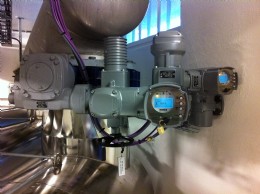Actuatorsí Role in Asset Management
AUMAís Generation .2 actuator range aids asset management

Mass customisation of modular actuators is offered by AUMA

Actuators are a key asset at any plant
It is well established that the management of a plantís physical assets has a significant impact on operational performance. It is also understood that assets need to be maintained to maximise output. Assets are defined as components relevant to a plantís industrial processes such as vessels, machines, piping, process control technology instruments, including actuators, and other equipment.
Asset management is growing in importance; it has achieved the status of a science enabling the plant to achieve whole life optimisation. The oil and gas industry has to a large extent championed adoption of asset management and other sectors including the power and water industries are embracing the management tool. The coal fired power plant RDK 8 in Karlsruhe, for example, has managers who recognise the business benefits of asset management and a system incorporating actuation technology will be implemented.
When defining asset management systems it is useful to highlight two primary tasks. The first is the signalling of conditions that cause a failure in order that measures can be taken to prevent these situations. The second is the supply of complex information relating to the maintenance requirement of a device to eliminate the static (predefined) maintenance intervals.
Actuators and automation
Automation is at the heart of a power plantís asset management and actuators have a key role operating valves which are vital to the stationís final control processes. Actuators are used in a range of applications that are critical in optimising plant efficiency.
One significant task performed by actuators is their ability to monitor the development of torque requests and to update the Distributed Control System (DCS) of the status of both the actuation equipment and the valve.
Modern actuator controls are equipped with microcontrollers. Since their introduction approximately 20 years ago, the functionality of actuators has been extended significantly and in the 1990s, the basic facility of preventative maintenance by logging and assessing operating data of field devices was identified. Addressing this situation, modern electric actuators have evolved to offer a field device solution with internal status monitoring Ė as such, they independently monitor that specified operation conditions are met. This includes pre-defined operation times or recording the number of starts. These variables are easy to record with microcontroller technology. Monitoring other variables has required additional hardware within actuators including torque monitoring, sensors for continuous recording of temperatures (motor, gearbox and electronics) and vibration sensors.
The actuator industry has, therefore, embraced the needs of asset management as it is possible to monitor device-specific service conditions, such as permissible ambient temperature. Additionally, the new era of actuator design also facilitates monitoring permissible vibration, maximum number of starts or operating times and the definition of customer-specific limit values. For example, a reference torque characteristic can be recorded after commissioning.
Further evidence of the actuator industry supporting asset management is the availability of mass customisation where each product is commissioned and tested against an individual specification. Unique reference numbers are a further aid to asset management and tracking. In conclusion, asset management is much more than a buzz term for business. It offers real advantages to end users and, as such, the actuation industry needs to embrace the science with practical solutions to aid plant processes.

| Telephone: | 01295 221270 |
| Email: | enquiry@bvaa.org.uk |
| Website: | www.bvaa.org.uk |
| More information on the British Valve and Actuator Association BVAA Member Directory Page |
Search related valve / actuator articles: British Valve and Actuator AssociationIssue 22Master Class












